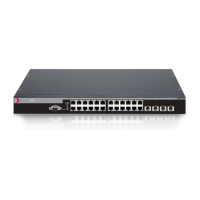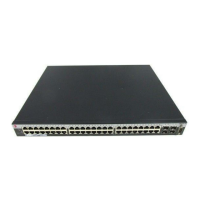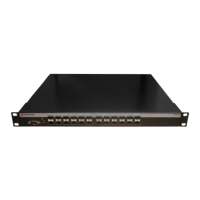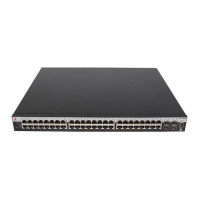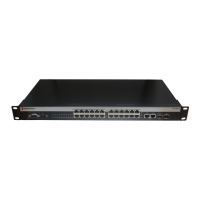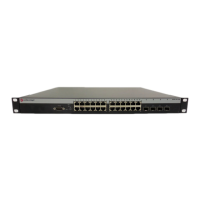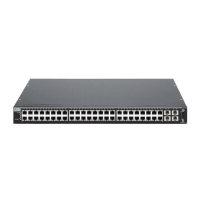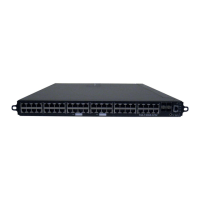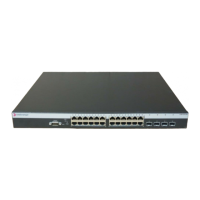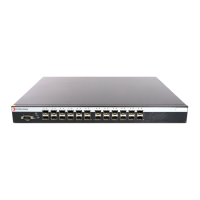
Do you have a question about the Enterasys SecureStack C2 C2G170-24 and is the answer not in the manual?
General network operations and CLI management knowledge are helpful for configuring the SecureStack device.
The guide is organized into chapters covering various configuration tasks, from introduction to advanced features.
Lists Enterasys Networks documents that may help with setup, control, and management of the SecureStack device.
Explains conventions used in the text, including font types and icons.
Provides methods to contact Enterasys Networks for support, including web, phone, and internet mail.
Overview of SecureStack C2 CLI interface capabilities for network management and configuration.
Describes methods for managing the SecureStack C2 switch, including local and remote connections.
Lists factory default settings for basic switch operation, including CDP, EAPOL, and IP configurations.
Explains how to navigate the CLI, get help, and use basic line editing commands.
Explains how SecureStack C2 products are stackable switches that provide a management platform for a group of up to eight units.
Procedure for installing a new stack of up to eight units out of the box, including physical connections and power-on sequence.
Procedure for installing previously configured member units into a stack, including renumbering.
Procedure for installing a new unit into an existing stack, assuming clean configuration and same firmware version.
Process for creating a virtual switch configuration before adding a physical device to a stack.
Important points to remember when using the clear config command in a stack environment.
Discusses functionality differences between SecureStack C2 and C3 switches when mixed in a stack.
Lists and describes commands for reviewing, configuring, and managing switches in a SecureStack C2 stack.
Quick reference for CLI commands needed to begin basic C2 switch operation, including password and IP setup.
Guides on changing default user login and password settings, and adding new user accounts.
Procedures for displaying and setting system IP address and other basic system properties.
Explains how to upgrade firmware via TFTP or serial port, and store dual images.
Steps to downgrade to a previous version of code, including backing up configuration.
Instructions to display and set the image file the switch loads at startup.
Steps to enable or disable Telnet and start a Telnet session to a remote host.
Covers configuration persistence modes, saving configurations, and file management commands.
Procedures to clear the CLI screen or close the CLI session.
Instructions to reset one or more switches and clear user-defined configuration parameters.
Explains how to verify status and enable/disable WebView, the embedded web server.
Describes how to gather common technical support information for troubleshooting.
Important notice regarding commands applying only to PoE-equipped devices and consulting the Installation Guide.
How to review and configure the Enterasys CDP discovery protocol to discover network topology.
How to review and configure the Cisco discovery protocol to discover network topology and recognize PDUs from Cisco phones.
Overview of LLDP and LLDP-MED, their benefits, and how they send and receive information.
Provides a summary of port types and connections for various SecureStack C2 models.
How to display operating status, duplex mode, speed, and traffic statistics for ports.
Procedures to disable/enable ports and assign an alias to a port.
How to review and set operational speed and duplex mode for ports.
How to enable and disable jumbo frame support on ports for Gigabit Ethernet.
How to review, disable/enable auto-negotiation, and configure port advertisement.
How to review, enable, or disable port flow control to manage transmission between devices.
How to configure link flap detection function and disable/re-enable link traps.
How to review and set the broadcast suppression threshold per port to limit broadcast frames.
How to configure port mirroring to redirect traffic for analysis and connection assurance.
Explains LACP operation, terminology, and how it logically groups interfaces for bandwidth increase.
How to use the Protected Port feature to prevent ports from forwarding traffic to each other.
SNMP is an application-layer protocol for exchanging management information between network devices.
Describes the initial and second releases of SNMP, including enhancements.
Describes the most recent version of SNMP with security enhancements like message integrity, authentication, and encryption.
Explains authentication strategy for users and groups, and permitted security levels.
How devices allow access to all SNMP MIBs or contexts, and how to specify context for restricted access.
Instructions on how to review SNMP statistics.
How to review and configure SNMP users, groups, and communities.
How to review and configure SNMP access rights, assigning privileges and security levels.
How to review and configure SNMP MIB views, which map SNMP objects to access rights.
How to review and configure SNMP target parameters controlling where SNMP notifications are sent.
How to review and configure SNMP target addresses that receive SNMP notification messages.
How to configure SNMP notification parameters and optional filters.
Example of SNMP trap configuration showing association of parameters with criteria and mapping to a target address.
Summary of Spanning Tree Configuration commands and their usage.
Explains STP, RSTP, and MSTP protocols for resolving physical loops in networks.
Lists functions performed by the SecureStack C2 device for Spanning Tree Protocols.
Describes the Loop Protect feature for preventing or short-circuiting loop formation in networks with redundant paths.
How to display and set Spanning Tree bridge parameters like priority, hello time, and path cost.
How to display and set Spanning Tree port parameters.
How to display and set global, per port, and per SID Loop Protect parameters.
Summary of SecureStack C2 system capabilities to implement 802.1Q virtual LANs (VLANs).
Explains the syntax for designating VLANs and port numbers in CLI commands.
Procedure to create a management-only VLAN for secure access to device management tasks.
How to display configured VLANs, port allowances, and traffic transmission with VLAN tags.
Procedures to create a new static VLAN or enable/disable existing VLANs and assign names.
How to assign default VLAN IDs, configure ingress filtering, and set frame discard mode.
How to assign or remove ports on the egress list of a VLAN to determine transmit eligibility.
How to configure a host VLAN for access by select devices, securing the host port for management tasks.
Describes the device operation under GARP application for dynamic VLAN creation across a switched network.
Summary of SecureStack C2 devices' support for policy profile-based provisioning of network resources.
How to review, create, change, and remove user profiles related to business-driven policies.
How to review, create, assign, and unassign classification rules to policy profiles.
How to assign and unassign ports to policy profiles.
How to assign mission-critical data to higher priority by delaying less critical traffic during congestion.
Summary of commands for configuring port priority characteristics.
How to view or configure port priority characteristics, including default CoS transmit priority.
How to view port priority to transmit queue mapping and configure ports for frame transmission based on priority.
How to set priority mode and weight for available transmit queues on physical ports.
How to limit the rate of inbound traffic on a per port/priority basis.
Describes IGMP's role in IP multicast group management and how it optimizes switched network performance.
Explains IGMP's mechanism for hosts to inform their device about specific multicast group subscriptions.
Explains multicasting for real-time applications and network overhead reduction.
Instructions for configuring IGMP snooping from the switch CLI.
How to configure IGMP on routing interfaces.
How to display and configure system logging, including Syslog server and default settings.
How to display switch events and command history, set history buffer size, and display/disconnect user sessions.
How to display or delete switch ARP table entries and display MAC address information.
How to configure SNTP to synchronize device clocks in a network.
How node alias feature helps determine MAC address and location of end-stations using Layer 3 alias information.
RMON provides network fault diagnosis, planning, and performance tuning, extending SNMP MIB capability.
Constraints for RMON Packet Capture/Filter Sampling and Port Mirroring.
How to display, configure, and clear RMON statistics.
How to display, configure, and clear RMON history properties and statistics.
How to display, configure, and clear RMON alarm entries and properties.
How to display and clear RMON events, and configure RMON event properties.
How to display RMON channel and filter entries.
How to display RMON capture entries, configure, enable, or disable capture entries.
DHCP for IPv4 is a network layer protocol for automatic or manual assignment of IP addresses and configuration information.
Configurable function on routing interfaces to forward DHCP client requests to a DHCP server on a different network.
Provides basic IP configuration information to clients using the DHCP protocol.
How to configure DHCP server parameters, display and clear address binding, server statistics, and conflict information.
How to configure and clear DHCP address pool parameters and display address pool configuration.
Monitors DHCP messages to filter harmful messages and build a database of authorized address bindings.
How the hardware identifies incoming DHCP packets and forwards client messages.
How the DHCP snooping application uses DHCP messages to build and maintain the bindings database.
Enforces a rate limit for DHCP packets received on untrusted interfaces to protect against attacks.
Basic configuration procedure for DHCP snooping.
Lists commands for configuring DHCP snooping.
Security feature that rejects invalid and malicious ARP packets by validating sender MAC and source IP addresses.
Basic configuration procedure for dynamic ARP inspection.
Lists commands for configuring dynamic ARP inspection.
Essential tasks to perform from the switch CLI before configuring routing.
Describes different modes of router operation for issuing commands.
How to enable routing interface configuration, create interfaces, review status, set addresses, and review running configuration.
How to review and configure the routing ARP table, enable proxy ARP, and set MAC addresses.
How to configure IP broadcast settings.
How to review IP traffic, configure routes, send router ICMP messages, and execute traceroute.
How to disable or enable sending ICMP redirect packets to the switch CPU.
How to activate license keys for advanced routing protocols like OSPF, DVMRP, VRRP, and PIM-SM.
How to enable and configure the Routing Information Protocol (RIP).
How to enable and configure the Open Shortest Path First (OSPF) routing protocol.
How to enable and configure the Distance Vector Multicast Routing Protocol (DVMRP) on an interface.
How to enable and configure the ICMP Router Discovery Protocol (IRDP) on an interface.
How to enable and configure the Virtual Router Redundancy Protocol (VRRP).
How to enable and configure Protocol Independent Multicast in Sparse Mode (PIM-SM).
Explains IPv6 proxy routing functionality in mixed C2/C3 stacks for IPv6 unicast routing and tunneling.
Discusses limitations of proxy routing, including mask usage and stack bandwidth.
Procedure for adding C3 switches to a C2 stack for management redundancy and configuring management priority.
Describes available methods for controlling user access, monitoring, and managing the switch.
How to use RADIUS Filter-ID to dynamically assign policy profiles or management levels to users.
Guides on reviewing, enabling/disabling RADIUS client, setting server parameters, and resetting settings.
How to review and configure 802.1X authentication for ports using EAPOL for user authorization.
How to review, disable, enable, and configure MAC authentication for source MAC addresses.
How to allow users to authenticate using multiple methods on the same port.
How to use RADIUS tunnel attributes to place a port into a particular VLAN based on authentication results.
How to lock MAC addresses to ports, preventing unauthorized devices and MAC spoofing.
How to review, enable, disable, and configure Port Web Authentication.
How to review, enable, disable, and configure the Secure Shell (SSH) protocol.
How to review and configure security access control lists (ACLs) to permit or deny access.
